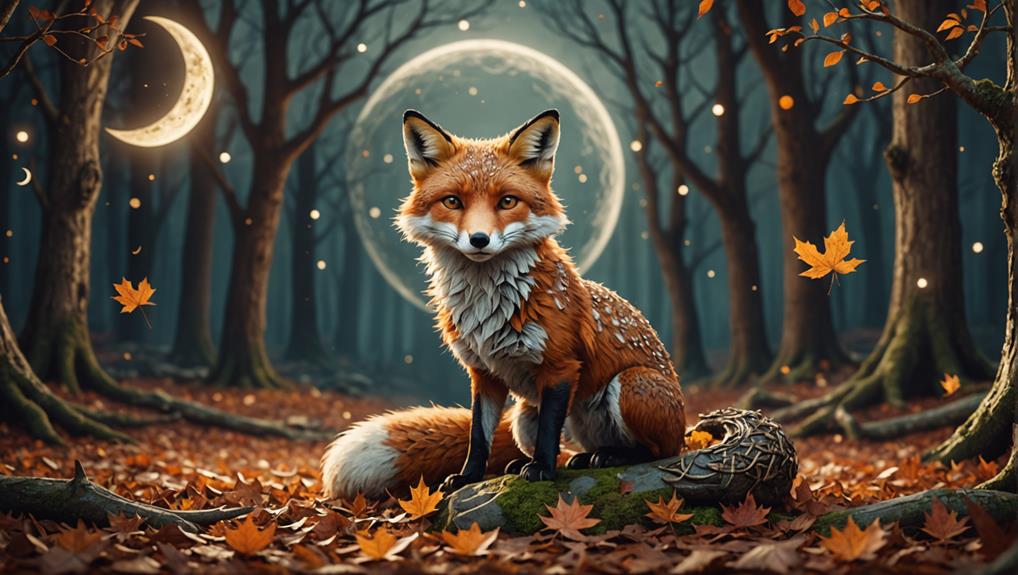As you explore folklore, you'll find that foxes consistently symbolize cleverness, adaptability, and cunning, representing intellect over brute strength across cultures. From Slavic mythology to Japanese Kitsune, foxes embody these traits, often serving as tricksters and wise guides. In Celtic culture, they're shapeshifters and spirit guides, while in African folklore, they're trickster gods, outmaneuvering more powerful entities. Foxes even pair with Coyotes in Native American mythology, teaching wisdom and humility. With their complex, multifaceted nature, it's no wonder their significance extends to contemporary storytelling, and there's more to uncover about these fascinating creatures.
Contents
Cultural Significance of Foxes
Embracing the role of cunning tricksters, foxes have woven themselves into the fabric of folklore across diverse cultures, reflecting human characteristics and moral lessons that continue to resonate with us today.
As you delve into the world of folklore, you'll find that foxes occupy a significant role, often embodying traits of cunning and adaptability. These clever creatures have managed to symbolize both wisdom and the consequences of arrogance, depending on the cultural context.
In Slavic mythology, foxes are primarily depicted as clever tricksters, often associated with intellect triumphing over brute strength.
Meanwhile, in Japanese folklore, the Kitsune serves a dual purpose as both a benevolent spirit and a malevolent figure, showcasing the complexity of fox symbolism in Asian cultures.
As you explore the cultural significance of foxes, you'll discover that their adaptability and wit have made them a staple in modern storytelling and media, reinforcing their cultural significance as symbols of complexity in narratives.
Mythological Roles Across Cultures
As you explore the world of folklore, you'll find that foxes play a wide range of mythological roles across cultures, reflecting their adaptability and the complexity of human nature.
From cunning tricksters to wise guides, foxes in popular folklore embody the duality of human experience. In Slavic tales, they outsmart foes with their intellect, while in Japanese mythology, kitsune fox spirits showcase their magical powers.
In Native American stories, the fox accompanies Coyote, teaching wisdom and humility. Celtic mythology portrays them as shapeshifters and spirit guides, highlighting their connection to nature.
Meanwhile, African folklore depicts foxes as trickster gods, teaching moral lessons about human behavior. Across cultures, foxes have become synonymous with cleverness, adaptability, and a touch of mischief.
As you delve deeper into these mythological roles, you'll discover that the fox spirit continues to captivate our imagination, inspiring us to embrace our own complexities and contradictions.
The Cunning Fox Archetype

Across cultures, the cunning fox archetype emerges as a dominant figure in folklore, captivating us with its cleverness and resourcefulness.
You'll find that foxes often embody trickster traits, symbolizing intelligence and resourcefulness, as seen in Aesop's Fables. In Slavic culture, they're frequently portrayed as deceivers, representing the theme of intellect triumphing over brute strength in various folktales.
The duality of the fox archetype is highlighted in Japanese mythology with the kitsune, which can embody both benevolent and malevolent characteristics. This complexity is showcased in human interactions, raising moral questions about loyalty and deception.
Folktales like "Kolobok" and "The Wolf and the Fox" illustrate the cunning fox's survival skills, making you ponder the fine line between cleverness and deceit.
In popular culture, metaphors and idioms like "sly as a fox" reinforce the lasting perception of foxes as symbols of cunning and cleverness, reflecting their impact on our collective imagination.
Spiritual Symbolism and Transformation
Beyond the cunning fox archetype, you'll discover that foxes also hold a profound significance in spiritual symbolism, guiding us through transformative experiences and symbolizing intuition, resilience, and adaptability in the face of challenges.
In many cultures, foxes were seen as spiritual guides, offering wisdom and insight to those seeking it. In Celtic mythology, foxes were depicted as shapeshifters, capable of transforming between human and canine forms, embodying adaptability and cleverness.
The Japanese Kitsune, a revered fox spirit, represents duality in spirituality, associated with both good fortune and cunning deception, reflecting the complexities of human traits.
Similarly, in Native American folklore, the fox is frequently portrayed as either a wise companion or a guiding spirit, emphasizing the balance between wisdom and trickery in its representations.
Foxes in Contemporary Culture

In the realm of modern storytelling, foxes continue to captivate audiences with their clever charm, adapting to new mediums and narratives.
You've likely noticed how foxes have become a staple in popular culture, symbolizing cleverness and wit. In animated films like Disney's "Zootopia," characters like Nick Wilde embody both charm and complexity.
Fox imagery also frequently appears in children's literature, such as in Beatrix Potter's stories, where they're portrayed as playful and clever.
Even e-commerce branding often utilizes fox imagery to evoke slyness and allure, reflecting the animal's cultural significance in representing strategic thinking and creativity.
You've probably seen references to foxes in popular media, like in "Teen Wolf" and "The Vampire Diaries," where they're presented as both protective and malevolent figures.
The continued use of fox symbolism in modern storytelling, including music projects like Ylvis's "What Does the Fox Say?", links traditional folklore to contemporary culture, illustrating the enduring relevance of foxes in popular narratives.
Global Myths and Folklore Examples
As you explore the fascinating realm of foxes in global myths and folklore, you'll discover that these cunning creatures have been imbued with symbolic meanings across cultures.
From trickster gods in African tales to shapeshifting spirits in East Asian legends, foxes have been represented in diverse and intriguing ways.
Foxes in Cultural Myths
You might be surprised to learn that foxes have earned a reputation as cunning tricksters across various cultures and folklore traditions. From Aesop's "The Fox and the Grapes" to European fables like "Reynard the Fox," foxes are often characterized as clever and shrewd.
In African mythology, the Dogon culture features foxes as trickster gods, highlighting their role in navigating life's challenges through wit. Meanwhile, in East Asian cultures, the Kitsune in Japanese folklore possesses the ability to shapeshift and is revered as a powerful spirit associated with the rice goddess Inari, demonstrating both benevolent and malevolent traits.
In Native American folklore, foxes are often represented as wise companions to the Coyote figure, symbolizing intelligence and adaptability while playing significant roles in creation myths.
As you delve into these cultural myths, you'll discover that foxes have been woven into the fabric of folklore, embodying cleverness, deception, and adaptability. Their cunning nature has captivated storytellers and audiences alike, earning them a permanent place in the realm of folklore.
Fox Symbolism Explained
Cultural myths and folklore are replete with symbolism, and the fox, with its cunning reputation, is no exception. You'll find that fox symbolism is found in folklore across the globe, representing a range of traits.
In many cultures, foxes are seen as cunning tricksters, symbolizing cleverness and wit. This is evident in Aesop's Fables, where they represent intelligence and deceitful behavior.
However, the Japanese Kitsune exhibits duality, revered as a divine protector while also depicted as a manipulative spirit.
In Slavic mythology, foxes embody intellect, often outsmarting stronger opponents, emphasizing the theme of wit over physical strength.
Native American folklore portrays foxes as wise companions, symbolizing benevolence and offering moral lessons.
Meanwhile, European traditions feature figures like Reynard, reflecting their adaptability and role in moral tales where their cleverness leads them into complex scenarios.
As you explore these examples, you'll discover that fox symbolism is rich and multifaceted, inviting you to consider the complexities of human nature.
Mythical Fox Representations
Delve into the realm of mythical fox representations, where these cunning creatures take on a life of their own in global myths and folklore.
You'll discover that the Red Fox, with its fiery coat, is just the beginning of the fascinating stories surrounding these mystical beings.
In Celtic culture, foxes are revered as spirit guides, embodying wisdom and protection.
Meanwhile, the Japanese Kitsune, with its nine tails, personifies a dual nature – benevolent guardian and mischievous trickster.
In African folklore, foxes are depicted as cunning trickster gods, outsmarting more powerful beings with ease.
Reynard the Fox, a medieval European literature character, exemplifies fox cunning, reflecting societal norms and moral lessons through his mischievous escapades.
In Native American mythology, the fox is often paired with the Coyote, symbolizing wisdom, adaptability, and serving as both a helper and punisher for human arrogance.
The Huli jing, a Chinese fox spirit, adds another layer of complexity, often taking on human form to interact with mortals.
As you explore these mythical fox representations, you'll uncover the rich cultural significance behind these enigmatic creatures.
Final Thoughts
As you've seen, foxes have been weaving in and out of folklore for centuries, leaving behind a trail of cunning, wisdom, and transformation. Remember, "curiosity killed the cat, but satisfaction brought it back" – and our curiosity about foxes has certainly led to a satisfying exploration of their cultural significance. So, the next time you cross paths with a fox, whether in myth or in real life, take a moment to appreciate the cleverness and mystique that's been building up around them for centuries.














